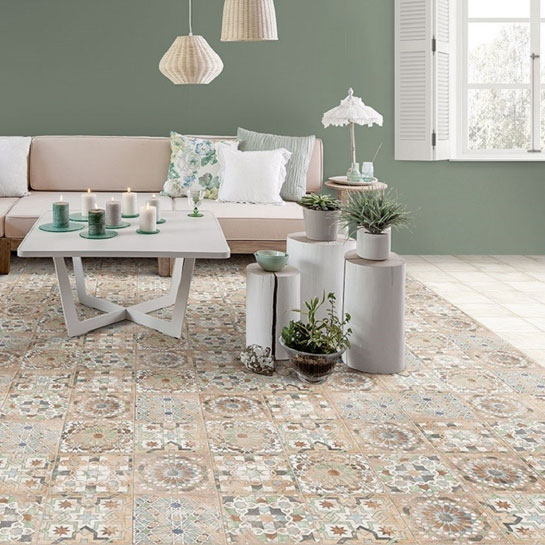Nowadays, there are several materials that offer an exceptional degree of resistance. This is the case, for example, of porcelain stoneware, which is part of most of the tiles you will find in our catalog. But do you know how to protect the pavements in those areas of greater passage within your home?
Undoubtedly, this is an issue of great relevance, since, if you do not make an effort to protect the floor, it will end up losing part of its aesthetic and functional qualities. Therefore, in ParaTuReforma we have decided to dedicate this article to the protection of this fundamental part of any home.
How to protect pavements
The tasks related to floor protection cover various aspects depending on the area in which the floor is located. In most homes, the bathroom, kitchen, living room and entrance hallway are the areas of highest traffic. In addition, during the summer months, balconies, terraces, patios and, in general, any other outdoor space in the home also fall into this category.
In general terms, floor maintenance is based on cleaning and the periodic application of certain treatments aimed at restoring its original properties. In the following sections we analyze it in detail.
Cleaning
Dirt is the main enemy of the aesthetic finish of any floor. In this sense, it is easier to remove it from tiles that are laid indoors. Especially in the living room and bedrooms, as they do not require anti-slip qualities.
Bathroom, kitchen and terrace floors, on the other hand, must have this non-slip feature to prevent slips and falls. This makes them rough to the touch and, therefore, dirt tends to accumulate. Remember that porcelain stoneware is not a porous material, so even if the surface gets dirty, stains will never leave marks.
In most cases, the cleaning of this type of floors in high traffic areas has to be done with:
- A soft-bristled broom, an upright vacuum cleaner or a robot vacuum cleaner.
- A mop.
- Hot water.
- A specific product that restores the shine to the surface of the tiles.
In addition, adding a few drops of a protective product for porcelain floors or the specific type you have in your home is also highly recommended. The reason? It will prevent stains from becoming encrusted and will make it even easier to clean with these utensils.
Maintenance
For its part, pavement maintenance in high traffic areas must be done by applying certain specific products:
- Waterproofing. They are especially recommended for all floors with a certain degree of porosity, such as natural stone. However, it is also useful for porcelain floors, as it adds an extra layer of protection against rain and humidity.
- Joint protectors. These are the weakest elements of any pavement, since it is a space between tiles that is only filled by grout. These products make the joints immune to water and avoid having to apply a new grout every so often.
It is important to remember that all these products must be applied when the floor surface is completely clean. Otherwise, there is a risk that they will not offer all their qualities.
On the other hand, you will need to protect your tiles from saltpetre if you live near the beach. This element, which travels through the air from the sea, can cause serious damage to the aesthetics of your outdoor flooring. Fortunately, there are products that prevent its effects.

Water repellents for terrace floors
Many users confuse them with waterproofing products, but they are not the same. It is true that these products also create an additional barrier against liquids. But they also prevent damp from forming and allow floors to breathe. Of course, using waterproofing products only makes sense on terraces, porches and patios, since these are the areas most exposed to moisture.
Protection of the soil when renovating
A renovation is a very delicate moment for the floor. The main reason is that there is a risk of staining with cement, paint or plaster. In addition, it can suffer scratches (for example, when moving the staircase) or blows from falling tools or any other type of utensil.
Some people use newspaper to cover the tiles and avoid these problems. However, this is not a material with sufficient consistency to prevent them completely. A much more effective alternative is protective felt. It is usually sold in sheets of 10 square meters and has these characteristics:
- Once in place, it does not wrinkle or move.
- It does not need adhesive tape or any glue to be fixed to the floor, so it leaves no residue or marks.
- It adapts perfectly to all types of surfaces.
- It is non-slip, which minimizes the risk of falls and accidents.
- It can be used more than once.
- It is waterproof.
- Cushions shocks.
But how to protect the pavements with this type of utensils? It is very simple. Just unroll the protective felt (sold in rolls for easy transport) and place it on the floor. In addition, it is a material that can be cut with a cutter or simple scissors to better adapt to the shape of the corners. Then, it is placed on the surface and that’s it!
Protecting the soil is easier than you think
We are sure that now you know how to protect the pavements located in the areas of greater passage inside your home. In ParaTuReforma we offer you a wide variety of products valid to undertake this task, so do not hesitate to take a look at our catalog. And if you have any additional questions or would like more information, please contact our customer service. Our experts will help you with everything you need.


